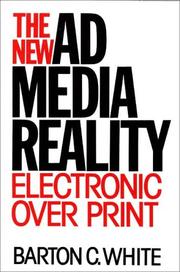| Listing 1 - 5 of 5 |
Sort by
|
Book

ISBN: 9782753529229 2753529221 2753561575 Year: 2018 Volume: *5 Publisher: Rennes : Presses universitaires de Rennes,
Abstract | Keywords | Export | Availability | Bookmark
 Loading...
Loading...Choose an application
- Reference Manager
- EndNote
- RefWorks (Direct export to RefWorks)
On aurait pu supposer que la double vocation de la télévision, tout à la fois outil de diffusion au service de l'information, de la culture et du divertissement, et moyen de création central dans le paysage audiovisuel depuis les années 1950, la disposait à entretenir des liens privilégiés avec les arts, dans leur pluralité. Or, la réalité du phénomène télévisé est bien différente. Non seulement la télévision réserve peu de place aux arts dans les grilles de ses programmes, mais elle-même exploite et développe peu ses ressources créatives. Et puisqu'elle se tient à la marge de la sphère culturelle « légitime », rares sont les discours qui s'attachent à l'étude qualitative de la production télévisuelle qui est principalement abordée sous les angles sociologiques et historiques. Pourtant, ce constat général mérite d'être nuancé dès lors que le regard se porte précisément sur certaines réalisations, notamment les émissions consacrées aux arts, qui ont été et sont encore, à leur meilleur, des ferments privilégiés d'une réflexion sur les spécificités de la création télévisuelle et d'une pensée sur le rôle du média dans la transmission d'une certaine conception de l'art et de la culture. Nous avons donc choisi dans cet ouvrage de donner la parole à des auteurs et producteurs de films et émissions consacrés aux arts au cours de treize entretiens qui sont l'occasion d'aborder tant les aspects esthétiques des programmes, retenus justement pour la qualité et l'originalité de leur approche, que les aspects concrets de leurs moyens de production et de diffusion qui nous renseignent « de l'intérieur » sur les politiques de programmation des grandes chaînes et sur les ambitions de leurs concepteurs.
Television and the arts --- Cultural television programs --- Télévision et arts --- Émissions culturelles télévisées --- Arts --- Télévision --- Et la télévision --- Émissions culturelles --- Educational television programs --- Educational television programs. --- Television and the arts. --- France. --- Télévision et arts --- Émissions culturelles télévisées --- Et la télévision. --- France --- Film Radio Television --- cinéma --- télévision --- histoire des médias

ISBN: 0826515193 0826515207 9780826515209 Year: 2006 Publisher: Nashville : Vanderbilt University Press,
Abstract | Keywords | Export | Availability | Bookmark
 Loading...
Loading...Choose an application
- Reference Manager
- EndNote
- RefWorks (Direct export to RefWorks)
Did the white male author become an endangered - and more valued - being once television's female, non-white audience (supposedly) wrote the novel's obituary? It almost goes without saying that the rise in popularity of television has killed the audience for “serious" literature. This is such a given that reading Fitzpatrick's challenge to this notion can be very disconcerting, as she traces the ways in which a small cadre of writers of "serious" literature--DeLillo, Pynchon, and Franzen, for instance--have propagated this myth in order to set themselves up as the last bastions of good writing. Fitzpatrick first explores whether serious literature was ever as all-pervasive as critics of the television culture claim and then asks the obvious question: what, or who, exactly, are these guys defending good writing against? Fitzpatrick examines the ways in which the anxiety about the supposed death of the novel is built on a myth of the novel's past ubiquity and its present displacement by television. She explores the ways in which this myth plays out in and around contemporary fiction and how it serves as a kind of unacknowledged discourse about race, class, and gender. The declaration constructs a minority status for the “white male author” who needs protecting from television's largely female and increasingly non-white audience. The novel, then, is transformed from a primary means of communication into an ancient, almost forgotten, and thus, treasured form reserved for the well-educated and well-to-do, and the men who practice it are exalted as the practitioners of an almost lost art. Such positioning serves to further marginalize women writers and writers of color because it makes the novel, by definition, the preserve of the poor endangered white man. If the novel is only a product of a small group of white men, how can the contributions of women and writers of color be recognized? Instead, this positioning abandons women and people of color to television as a creative outlet, and in return, cedes television to them. Fitzpatrick argues that there's a level of unrecognized patronization in assuming that television serves no purpose but to provide dumb entertainment to bored women and others too stupid to understand novels. And, instead, she demonstrates the real positive effects of a televisual culture.
American fiction --- Archaeological surveying --- Excavations (Archaeology) --- Literacy --- Mayas --- Popular culture --- Television broadcasting --- History and criticism. --- History. --- Antiquities. --- Kings and rulers. --- Influence. --- Fiction --- American literature --- anno 1900-1999 --- History and criticism --- United States --- Influence --- Littérature américaine --- CULTURE POPULAIRE --- Télévision --- Et la télévision --- ETATS-UNIS --- HISTOIRE --- 20E SIECLE --- Etats-Unis

ISBN: 0899307957 Year: 1993 Publisher: Westport ; London Quorum Books
Abstract | Keywords | Export | Availability | Bookmark
 Loading...
Loading...Choose an application
- Reference Manager
- EndNote
- RefWorks (Direct export to RefWorks)
Advertising --- Broadcast advertising --- Publicité --- Publicité à la radio et la télévision --- Reclame --- Reclame op radio en televisie --- 659.1 --- #SBIB:309H2811 --- #SBIB:309H1713 --- reclame --- Ads --- Advertisements --- Advertising, Consumer --- Advertising, Retail --- Advertising, Store --- Commercial speech --- Consumer advertising --- Retail advertising --- Speech, Commercial --- Store advertising --- Business --- Communication in marketing --- Industrial publicity --- Retail trade --- Advertisers --- Branding (Marketing) --- Propaganda --- Public relations --- Publicity --- Sales promotion --- Selling --- Publicity. Advertising --- Reclame: bedrijfseconomische aspecten, productie- en distributiestructuren (bedrijfstak, media, mediaplanning) --- Mediatechnologie: nieuwe toepassingen (abonnee-televisie, electronic mail, desk top publishing, virtuele realiteit...) --- Advertising. --- Broadcast advertising. --- 659.1 Publicity. Advertising

ISBN: 9780415726627 0044458371 0044458363 9781315855929 9781317929130 9781317929147 9781138971912 9780044458371 041572662X Year: 2014 Volume: 2 Publisher: London New-York : Routledge,
Abstract | Keywords | Export | Availability | Bookmark
 Loading...
Loading...Choose an application
- Reference Manager
- EndNote
- RefWorks (Direct export to RefWorks)
[2014] This collection of papers examines the evolving relationship between the motion picture industry and television from the 1940s onwards. The institutional and technological histories of the film and TV industries are looked at, concluding that Hollywood and television had a symbiotic relationship from the start. Aspects covered include the movement of audiences, the rise of the independent producer, the introduction of colour and the emergence of network structure, cable TV and video recorders. Originally published in 1990.
Motion pictures and television --- Motion picture industry --- Television broadcasting --- Cinéma --- Industrie du cinéma --- Industrie de la télévision --- Et la télévision --- Télédiffusion --- -Motion pictures and television --- -#SBIB:309H1310 --- Moving-pictures and television --- Television and motion pictures --- Organisatorische aspecten van het filmwezen --- Cinéma et télévision --- Télédiffusion --- #SBIB:309H1310 --- #SBIB:309H500 --- 791.43 --- 791.44 --- 791.44 Filmproductie. Filmindustrie --- Filmproductie. Filmindustrie --- 791.43 Filmkunst. Films. Cinema --- Filmkunst. Films. Cinema --- Television --- De theoretische benadering van code en boodschap: algemene werken --- Cinéma --- Industrie --- Motion pictures and television - United States --- Motion picture industry - United States --- Television broadcasting - United States
Book
ISBN: 1479800120 9781479800124 9781479800742 1479800740 9781479800483 1479800481 Year: 2014 Publisher: New York : Baltimore, Md. : New York University Press, Project MUSE,
Abstract | Keywords | Export | Availability | Bookmark
 Loading...
Loading...Choose an application
- Reference Manager
- EndNote
- RefWorks (Direct export to RefWorks)
The emergence of "male-centered serials" such as The Shield, Rescue Me, and Sons Of Anarchy and the challenges these characters face in negotiating modern masculinities. Fromthe meth-dealing but devoted family man Walter White of AMC’s Breaking Bad,to the part-time basketball coach, part-time gigolo Ray Drecker of HBO’s Hung,depictions of male characters perplexed by societal expectations of men andanxious about changing American masculinity have become standard across thetelevision landscape. Engaging with a wide variety of shows, including TheLeague, Dexter, and Nip/Tuck, among many others, Amanda D. Lotzidentifies the gradual incorporation of second-wave feminism into prevailinggender norms as the catalyst for the contested masculinities on display incontemporary cable dramas.Examiningthe emergence of “male-centered serials” such as The Shield, Rescue Me, and Sons of Anarchy and the challenges these characters face in negotiatingmodern masculinities, Lotz analyzes how these shows combine feminist approachesto fatherhood and marriage with more traditional constructions of masculineidentity that emphasize men’s role as providers. She explores the dynamics ofclose male friendships both in groups, as in Entourage and Men of aCertain Age, wherein characters test the boundaries between the homosocialand homosexual in their relationships with each other, and in the dyadicintimacy depicted in Boston Legal and Scrubs. Cable Guys provides amuch needed look into the under-considered subject of how constructions of masculinitycontinue to evolve on television.
Masculinity on television. --- Men on television. --- Cable television --- Television broadcasting --- Cable TV --- CATV --- Community antenna television --- Television, Cable --- Subscription television --- Television relay systems --- Public-access television --- Men in television --- Television --- Social aspects --- Television americaine. --- Television. --- Series televisees americaines (Etats-Unis) --- Series televisees. --- Masculinite --- Teledistribution --- Hommes --- Hommes à la television. --- Masculinite à la television. --- Radio vision --- TV --- Artificial satellites in telecommunication --- Electronic systems --- Optoelectronic devices --- Telecommunication --- Astronautics --- Aspect social --- A la television --- Social aspects. --- Optical communication systems --- Etats-Unis. --- United States. --- ABŞ --- ABSh --- Ameerika Ühendriigid --- America (Republic) --- Amerika Birlăshmish Shtatlary --- Amerika Birlăşmi Ştatları --- Amerika Birlăşmiş Ştatları --- Amerika ka Kelenyalen Jamanaw --- Amerika Qūrama Shtattary --- Amerika Qŭshma Shtatlari --- Amerika Qushma Shtattary --- Amerika (Republic) --- Amerikai Egyesült Államok --- Amerikanʹ Veĭtʹsėndi︠a︡vks Shtattnė --- Amerikări Pĕrleshu̇llĕ Shtatsem --- Amerikas Forenede Stater --- Amerikayi Miatsʻyal Nahangner --- Ameriketako Estatu Batuak --- Amirika Carékat --- AQSh --- Ar. ha-B. --- Arhab --- Artsot ha-Berit --- Artzois Ha'bris --- Bí-kok --- Ē.P.A. --- EE.UU. --- Egyesült Államok --- ĒPA --- Estados Unidos --- Estados Unidos da América do Norte --- Estados Unidos de América --- Estaos Xuníos --- Estaos Xuníos d'América --- Estatos Unitos --- Estatos Unitos d'America --- Estats Units d'Amèrica --- Ètats-Unis d'Amèrica --- États-Unis d'Amérique --- Fareyniḳṭe Shṭaṭn --- Feriene Steaten --- Feriene Steaten fan Amearika --- Forente stater --- FS --- Hēnomenai Politeiai Amerikēs --- Hēnōmenes Politeies tēs Amerikēs --- Hiwsisayin Amerikayi Miatsʻeal Tērutʻiwnkʻ --- Istadus Unidus --- Jungtinės Amerikos valstybės --- Mei guo --- Mei-kuo --- Meiguo --- Mî-koet --- Miatsʻyal Nahangner --- Miguk --- Na Stàitean Aonaichte --- NSA --- S.U.A. --- SAD --- Saharat ʻAmērikā --- SASht --- Severo-Amerikanskie Shtaty --- Severo-Amerikanskie Soedinennye Shtaty --- Si︠e︡vero-Amerikanskīe Soedinennye Shtaty --- Sjedinjene Američke Države --- Soedinennye Shtaty Ameriki --- Soedinennye Shtaty Severnoĭ Ameriki --- Soedinennye Shtaty Si︠e︡vernoĭ Ameriki --- Spojené staty americké --- SShA --- Stadoù-Unanet Amerika --- Stáit Aontaithe Mheiriceá --- Stany Zjednoczone --- Stati Uniti --- Stati Uniti d'America --- Stâts Unîts --- Stâts Unîts di Americhe --- Steatyn Unnaneysit --- Steatyn Unnaneysit America --- SUA (Stati Uniti d'America) --- Sŭedineni amerikanski shtati --- Sŭedinenite shtati --- Tetã peteĩ reko Amérikagua --- U.S. --- U.S.A. --- United States of America --- Unol Daleithiau --- Unol Daleithiau America --- Unuiĝintaj Ŝtatoj de Ameriko --- US --- USA --- Usono --- Vaeinigte Staatn --- Vaeinigte Staatn vo Amerika --- Vereinigte Staaten --- Vereinigte Staaten von Amerika --- Verenigde State van Amerika --- Verenigde Staten --- VS --- VSA --- Wááshindoon Bikéyah Ałhidadiidzooígíí --- Wilāyāt al-Muttaḥidah --- Wilāyāt al-Muttaḥidah al-Amirīkīyah --- Wilāyāt al-Muttaḥidah al-Amrīkīyah --- Yhdysvallat --- Yunaeted Stet --- Yunaeted Stet blong Amerika --- ZDA --- Združene države Amerike --- Zʹi︠e︡dnani Derz︠h︡avy Ameryky --- Zjadnośone staty Ameriki --- Zluchanyi︠a︡ Shtaty Ameryki --- Zlucheni Derz︠h︡avy --- ZSA --- Η.Π.Α. --- Ηνωμένες Πολιτείες της Αμερικής --- Америка (Republic) --- Американь Вейтьсэндявкс Штаттнэ --- Америкӑри Пӗрлешӳллӗ Штатсем --- САЩ --- Съединените щати --- Злучаныя Штаты Амерыкі --- ولايات المتحدة --- ولايات المتّحدة الأمريكيّة --- ولايات المتحدة الامريكية --- 미국 --- Spojené obce severoamerické --- États-Unis --- É.-U. --- ÉU --- Masculinité (psychologie) --- Virilité --- Libido --- Masculinisme --- Phallocentrisme --- Machisme --- Différences entre sexes (psychologie) --- Identité sexuelle --- Attitude envers les hommes --- Et les hommes --- Relations avec les hommes --- Et la télévision --- Oeuvre télévisuelle --- Oeuvres --- Oeuvres pour la télévision --- Oeuvres télévisuelles --- À la télévision --- Adaptations télévisées --- Archives télévisuelles --- Audiovisuel --- Binge-watching --- Industrie de la télévision --- Journalisme de télévision --- Politique de la télédiffusion --- Publicité télévisée --- Sémiotique et télévision --- Téléspectateurs --- Télévision --- Télévision dans la communication religieuse --- Télévision dans la régulation des naissances --- Télévision en sciences --- Télévision et art --- Télévision et arts du spectacle --- Télévision et famille --- Télévision et histoire --- Télévision et jeunesse --- Télévision et lecture --- Télévision et littérature --- Télévision et mondialisation --- Télévision et musées --- Télévision et musique --- Télévision et personnes âgées --- Télévision et politique --- Télévision et religion --- Zapping --- Art de parler à la télévision --- Chaînes de télévision --- Critique de télévision --- Interviews télévisées --- Télédistribution --- Télévision en agriculture --- Télévision en circuit fermé --- Télévision en couleurs --- Télévision en développement rural --- Télévision en ondes décimétriques --- Télévision en relief --- Télévision haute définition --- Télévision par Internet --- Télévision par satellite --- Médias audiovisuels --- Radiodiffusion --- Antennes collectives, Réception par --- Câblodiffusion --- Câblodistribution --- Canaux spécialisés (télévision) --- Réseaux câblés --- Réseaux de télédistribution --- Télédiffusion par câble --- Télévision par câble --- Câbles de télécommunications --- Télécommunications --- Psychologie --- Dans l'art --- sociologie --- Travail --- Commande --- Personnel --- Appareils et matériel --- Audience --- Censure --- Courrier des téléspectateurs --- Droit --- Fréquences -- Attribution --- Impôts --- Influence --- Objectivité --- Production et réalisation --- Diffusion de films --- Réception par antenne collective --- AB --- Amerikanʹ Veĭtʹsėndi͡avks Shtattn --- Saharat ʻAmērik --- Si͡evero-Amerikanskīe Soedinennye Shtaty --- Soedinennye Shtaty Si͡evernoĭ Ameriki --- Spojené obce severoamerick --- Spojené staty americk --- Stáit Aontaithe Mheirice --- SUA --- Wááshindoon Bikéyah Ałhidadiidzooígí --- Zʹi͡ednani Derz͡havy Ameryky --- Zluchanyi͡a Shtaty Ameryki --- Zlucheni Derz͡havy --- Amerikanʹ Veĭtʹsėndi͡avks Shtattnė --- Homme --- Masculinité --- Patriarcat --- Prénoms masculins --- Relations entre hommes --- Vêtements d'homme --- Consommateurs masculins --- Dandys --- Hommes féministes --- Hommes forts --- Hommes seuls --- Hommes victimes de violence --- Homosexuels masculins --- Jeunes hommes --- Médias masculins --- Pastorale des hommes --- Prostitués --- Eunuques --- Frères --- Hommes âgés --- Hommes d'âge moyen --- Hommes de la bourgeoisie --- Hommes des classes moyennes --- Hommes du monde --- Mâles --- Censure télévisuelle
| Listing 1 - 5 of 5 |
Sort by
|

 Search
Search Feedback
Feedback About
About Help
Help News
News